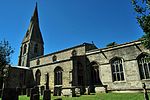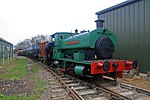Cribb's Meadow
Leicestershire and Rutland Wildlife TrustNational nature reserves in EnglandNature Conservation Review sitesSites of Special Scientific Interest in Leicestershire

Cribb's Meadow is a 4.2-hectare (10-acre) nature reserve east of Wymondham in Leicestershire. It is owned and managed by the Leicestershire and Rutland Wildlife Trust, and is designated a biological Site of Special Scientific Interest under the name Cribb's Lodge Meadows. It is also a National Nature Reserve and a Nature Conservation Review site, Grade 2.The embankment of a disused railway runs through this ridge and furrow neutral meadow on boulder clay. The diverse flora includes adder's tongue fern, pepper saxifrage, hayrattle and green-winged orchid.There is access from Fosse Lane, and a footpath runs through the southern end.
Excerpt from the Wikipedia article Cribb's Meadow (License: CC BY-SA 3.0, Authors, Images).Cribb's Meadow
Mill Lane, Melton Wymondham
Geographical coordinates (GPS) Address Nearby Places Show on map
Geographical coordinates (GPS)
| Latitude | Longitude |
|---|---|
| N 52.759 ° | E -0.669 ° |
Address
Cribb's Meadow
Mill Lane
NG33 5AF Melton, Wymondham
England, United Kingdom
Open on Google Maps









